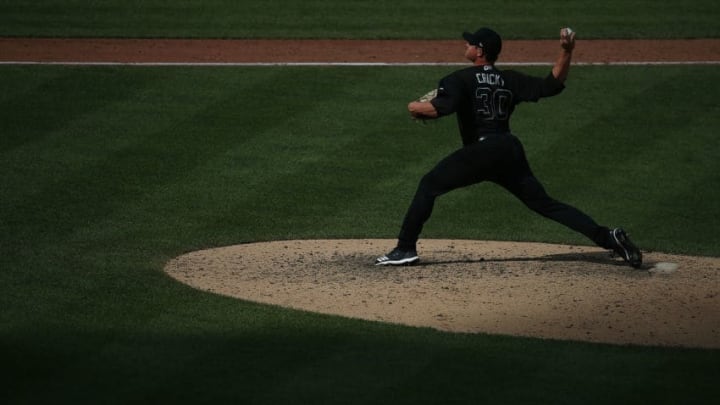Pittsburgh Pirates relief pitcher Kyle Crick had a strong breakout campaign in 2018, but suffered throughout the 2019 season. Going into his third season as Pirate, what should you expect from the right hander next season?
Kyle Crick had an outstanding 2018 season. In his debut season with the Pittsburgh Pirates, the hard throwing right hander posted a 2.39 ERA, 3.14 FIP and 1.13 WHIP across 60.1 innings of work. He was great at limiting home runs, allowing just three long balls. Crick also struck out 65 batters and walked just 23 of the 255 batters he faced. Eventually, he forced himself into the set-up role after showing he could handle high leverage situations (.548 opponent OPS in high leverage moments, .515 opponent OPS with runners in scoring position).
When the 2019 season rolled around, expectations were high for the former San Francisco Giant prospect as Crick was expected to be one of the Pittsburgh Pirates go to high leverage releivers. But Crick didn’t even come close to meeting those expectations. In an injury limited 49 innings, Crick allowed 27 earned runs and 10 home runs. Double what he allowed in both his 2017 rookie season and 2018 breakout season combined. This was due to a spike in his fly ball rate, seeing it rise to 42%, or a 4% jump from 2018. He also issued 35 walks, resulting in a poor 1.51 WHIP. But there still is hope for the relief pitcher as he enters the 2020 season.
First and foremost, expectations for Crick going into 2019 should have been a tampered down from what they were. Crick still had a xFIP of 4.00, a SIERA of 3.57 and a DRA of 4.41 in 2018. All three of those are way higher than his actual results, especially his xFIP and DRA. His 2018 DRA represented something fairly close to his 2019 ERA of 4.96.
Although he was a big regression candidate going into 2019, he still well under-performed to his 2018 expected stats. There’s still a lot of upside in Crick. One thing that Crick did improve upon in 2019 was strikeouts. Sure, he struck out a lot of batters in 2018, clocking in with a 25.5% strikeout rate. But that rose to 27% in 2019. He also induced many more ground balls. His ground ball percentage rose from 39.9% in 2018 to 43.7% in 2019. Which is a bit odd to see his ground ball and fly ball rate both moving in the same direction.
Crick was still well above average in the batted ball department. His 29.4% hard hit rate was the top 94th percentile in the MLB. Opponents only managed an 85.6 MPH exit velocity off of Crick. That also was in the 94th percentile of the MLB. Crick was under-performing by a large margin according to wOBA and xWOBA. He had an actual wOBA of .345, but it was expected to be in the low-300s at .313.
Crick is also in the top 94th percentile of the MLB in xBA at .196. Plus many of the extra base hits he gave up were undeserved or Crick just got unlucky on. Opponents had a .353 xSlugging vs Crick, but in reality that number was .432.
One of the main contributing factors to Crick’s 2019 struggles could be his change in pitch usage. In 2018, Crick used his fastball 57% of the time. He also occasionally mixed in his sinker, using it 15.9% of the time. His fastball got the best swing and miss results, as it had a 25% whiff rate, but the sinker was used to change eye levels of batters. His put away pitch was his slider, which he used 25.8% of the time. That pitch had a put away percentage of 25%.
But in 2019, those usage numbers looked a lot different. For one, Crick became a fastball/slider guy. His sinker usage dropped to just 11.9%. He also used his fastball nearly 7% less at 50.4%. His slider also saw a large increase in usage at 37.4%, over 10% more than in 2018. Crick’s slider had less movement on it than in 2018, as it dropped from 45.3 inches of vertical drop to 41.3 inches of drop. The decreased movement and higher usage, plus becoming much more predictable made it easier for batters to hit Crick in 2019.
Another culprit of his 2019 struggles was opponent launch angle. In 2018, his opponent launch angle was 12.1. But in 2019, that increased to 13.6. That launch angle is similar to Bryce Harper, and we all know how good of a batter Harper is.
Crick should improve given a new, better Pittsburgh Pirates coaching staff. He still is well above average in terms of exit velocity, hard hit rate, fastball spin rate (top 69th percentile), xBA, xSLG, and swing and miss/whiff percentage. Crick might just need to incorporate his sinker more. Afterall, it induced ground balls at a 64.1% rate in 2018. If Crick can get his home run rate and walk rate down, he should be a much better pitcher if or when the 2020 season starts. I’d expect an ERA around the mid-3s, a FIP in the low-3s and WHIP in the 1.1-1.2 range.
